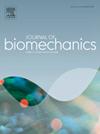Stability vs. performance: The role of weight shift during gait initiation for people with Parkinson disease
IF 2.4
3区 医学
Q3 BIOPHYSICS
引用次数: 0
Abstract
People with Parkinson disease (PwPD) demonstrate hypokinesia during gait initiation, marked by a decreased first step length and reduced anticipatory postural adjustment (APA) size. Effective postural control is critical for shifting from double to single limb support during gait initiation. Although PwPD are known to have impaired postural control strategies, its impact on spatial aspects of gait initiation remains unclear. This study investigated how different weight shift amplitudes onto the initial stance limb during gait initiation affect first step length, mediolateral APA size, and the ability to bring the centre of mass (COM) close to the centre of pressure (COP) for PwPD. We hypothesized that cueing for larger weight shifts would yield a larger APA, reduce the distance between COP and COM in the mediolateral direction (COM-COMx), and result in larger first steps. Eleven adults with idiopathic PD (Hoehn & Yahr Stages 1–3) were given visual biofeedback to cue weight shifts of 40, 60, and 80 % towards the initial stance limb before initiating gait. No significant difference was found between uncued and cued conditions for first step length (p = 0.210), however, cued conditions resulted in smaller mediolateral APA sizes (p < 0.001), and reduced COP-COMx compared to uncued trials (p < 0.001). A weak positive correlation was found between mediolateral APA size and first step length (ρ = 0.236, p = 0.005), suggesting a very small role of APAs in first step length amplitude in this population. In conclusion, cueing for increased weight shift amplitude improves stability but does not enhance first step length during gait initiation for PwPD.
稳定性与表现:体重变化在帕金森病患者步态启动中的作用
帕金森病(PwPD)患者在步态开始时表现出运动障碍,其特征是第一步长度减少和预期姿势调整(APA)大小减少。在步态开始时,有效的姿势控制对于从双肢支撑到单肢支撑的转变至关重要。虽然已知PwPD会损害姿势控制策略,但其对步态启动的空间方面的影响尚不清楚。本研究研究了在步态开始时,不同的体重移到初始站立肢体的振幅如何影响PwPD的第一步长度、中外侧APA大小以及使质心(COM)接近压力中心(COP)的能力。我们假设,更大的体重变化会产生更大的APA,减少COP和COM在中外侧方向(COM- comx)之间的距离,并导致更大的第一步。11例成人特发性PD (Hoehn &;Yahr阶段1-3)在开始步态之前给予视觉生物反馈,提示体重向初始站立肢体移动40%、60%和80%。在第一步长度上,未提示和提示组之间没有显著差异(p = 0.210),然而,提示组导致内侧APA尺寸较小(p <;0.001),与未经验证的试验相比,COP-COMx降低(p <;0.001)。中外侧APA大小与第一步长度呈弱正相关(ρ = 0.236, p = 0.005),表明APA对该人群第一步长度振幅的作用很小。综上所述,增加体重偏移幅度的提示改善了PwPD的稳定性,但并没有增加步态开始时的第一步长度。
本文章由计算机程序翻译,如有差异,请以英文原文为准。
求助全文
约1分钟内获得全文
求助全文
来源期刊

Journal of biomechanics
生物-工程:生物医学
CiteScore
5.10
自引率
4.20%
发文量
345
审稿时长
1 months
期刊介绍:
The Journal of Biomechanics publishes reports of original and substantial findings using the principles of mechanics to explore biological problems. Analytical, as well as experimental papers may be submitted, and the journal accepts original articles, surveys and perspective articles (usually by Editorial invitation only), book reviews and letters to the Editor. The criteria for acceptance of manuscripts include excellence, novelty, significance, clarity, conciseness and interest to the readership.
Papers published in the journal may cover a wide range of topics in biomechanics, including, but not limited to:
-Fundamental Topics - Biomechanics of the musculoskeletal, cardiovascular, and respiratory systems, mechanics of hard and soft tissues, biofluid mechanics, mechanics of prostheses and implant-tissue interfaces, mechanics of cells.
-Cardiovascular and Respiratory Biomechanics - Mechanics of blood-flow, air-flow, mechanics of the soft tissues, flow-tissue or flow-prosthesis interactions.
-Cell Biomechanics - Biomechanic analyses of cells, membranes and sub-cellular structures; the relationship of the mechanical environment to cell and tissue response.
-Dental Biomechanics - Design and analysis of dental tissues and prostheses, mechanics of chewing.
-Functional Tissue Engineering - The role of biomechanical factors in engineered tissue replacements and regenerative medicine.
-Injury Biomechanics - Mechanics of impact and trauma, dynamics of man-machine interaction.
-Molecular Biomechanics - Mechanical analyses of biomolecules.
-Orthopedic Biomechanics - Mechanics of fracture and fracture fixation, mechanics of implants and implant fixation, mechanics of bones and joints, wear of natural and artificial joints.
-Rehabilitation Biomechanics - Analyses of gait, mechanics of prosthetics and orthotics.
-Sports Biomechanics - Mechanical analyses of sports performance.
 求助内容:
求助内容: 应助结果提醒方式:
应助结果提醒方式:


